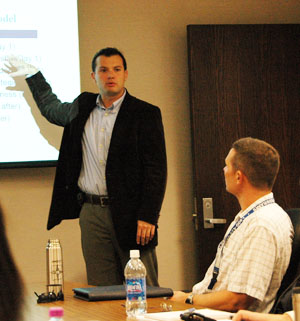By Chris Joyce

Phil Barnes, assistant director for Policy Analysis, Research & Innovation, leads a discussion about risk management. Photo by Nick Carpenter |
When considering whether Mn/DOT should, for example, turn a state highway back to a local government, replace an aging mainframe information system or find alternative bypass routes around a city, many department managers these days have turned to a process known as risk management to help them weigh the alternatives in tough decisions.
“Risk management is a systematic way to look at possible consequences of actions—or lack of action,” said Phil Barnes, assistant director for Policy Analysis, Research & Innovation. “It’s about getting ahead of things so we can make better decisions for the department, our partners and the public.”
Barnes, who has facilitated risk management sessions for 13 different Mn/DOT projects during the past year, noted that the process can be used for most decisions that affect an organization.
“When people get to feeling uneasy about making a decision, then maybe it’s a good idea to bring them together,” he said.
Hwy 197/Paul Bunyan Drive turnback in Bemidji
Such was the case recently for Bemidji/District 2, which was wrestling with the decision of whether or not to turn back Hwy 197/Paul Bunyan Drive to the city of Bemidji. Barnes brought together staff from District 2, the city of Bemidji and the Office of Land Management to identify and weigh the risks associated with the two alternatives before them: (1) Mn/DOT continues to own and operate Hwy 197, or (2) Bemidji assumes ownership and operation of the road.
Barnes said the group concluded that although there were risks associated with both alternatives, there was a perception that there would be less risk during the next five years if Mn/DOT maintained ownership of the highway.
In addition, to address the city’s concern that it would lose “control over its destiny,” the group came to an understanding that a cooperative agreement about when and what kinds of changes could be made on the road would be productive.
“For D2, the process enabled Mn/DOT and the city of Bemidji a forum for openly and honestly discussing this matter,” said Lynn Eaton, District 2 engineer, who shared his district’s experiences at the Managers’ Conference in mid-December.
“We each had to make our case and identify how a potential turnback would affect each party. Each got an opportunity to comment on the other’s potential risk. It exposed where each other’s greatest threats were and gave the opportunity for both parties to walk away from the table with a better understanding of the issue,” he said.
“Even though Mn/DOT was not able to use the opportunity to turn MN-197 back to the city, D2 learned what was important and is using that knowledge to take the turn back idea to another level.”
Transportation Information System replacement
Jonette Kreideweis, Transportation Data & Analysis director, also shared her office’s experiences at the Managers’ Conference.
“The risk management process provided a structure for reviewing alternatives and assessing risks to move forward for replacing TIS,” she said, referring to the department’s 30-year-old, mainframe-based, transportation data information system.
“We were a group with strong opinions and were risk-averse after the failure of the last replacement attempt,” she said.
Barnes facilitated 10-12 hours of discussion for a group of TIS stakeholders, which included TDA staff as well as representatives from Bridges; Information & Technology Services; Land Management; Materials and Road Research; Metro District; and Traffic, Safety and Operations.
“The process gave a structured way to weight options, assess risks and identify best options for moving forward that everyone could live with and hope will meet our needs,” Kreideweis said.
In the end, the group decided to go with an off-the-shelf product, instead of selecting the typical solution of developing and building in-house, she said.
Although these two examples show how successful the risk management process can be on certain types of decision-making, Barnes said it may not work with unilateral decisions or low-risk projects.
“As a neutral party, it’s very humbling to be a part in these discussions,” Barnes said. “These projects have big impacts on Minnesota—it feels good to be part of the decision.”
What’s ahead
Barnes and staff have already scheduled time in 2010 for several more projects, including evaluating the RouteBuilder system (the program used to route oversized vehicles through the state), jumpstarting project management plans for Chapter 152 bridge projects, delivering the new stimulus program and assessing the ideas collected during Emagination-JAM to see which should go forward.
For more information, see the risk management Web page, or contact Barnes at philip.barnes@state.mn.us or 651-366-3171. |



